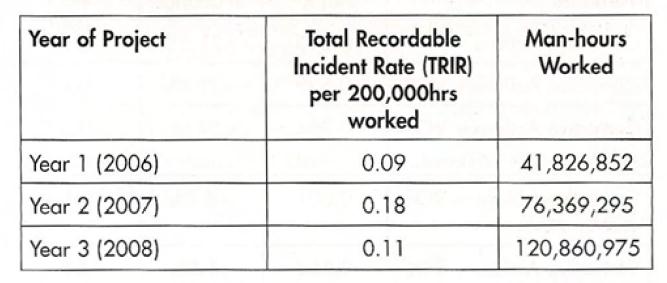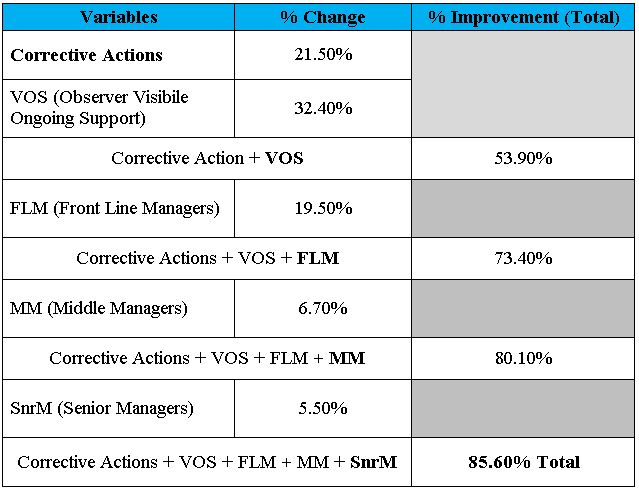Relationship Based Safety: Moving Beyond Culture and Behavior was published in the ASSE Safety Professional December 2012 issue. This six part series will break down the main concepts and explain the concept of Relationship Based Safety (RBS), a new safety management perspective based on findings from the scientific community on the application of Complexity Theory to organizations. We will cover:
- Introduction into Relationship Based Safety: What is it? Where did it come from? How is it different than anything else we’ve seen?
- Complexity Management, Relationship Psychology, and Relational Coordination: How do these theories affect the way we think about safety management?
- How do these concepts affect our understanding of how to improve communication and collaboration to achieve safety excellence?
- Practical Drift: the human tendency to drift away from standard procedures without documentation. How is it spotted before an accident? How is it managed?
- Putting RBS into place: Practical applications and implementation.
- The implications for safety leadership: More reliance on collaboration and interdependence requires competence in people skills.
Introduction to Relationship Based Safety (RBS)
Relationship Based Safety (RBS) adds value to the safety management field by providing a more complete understanding of the influences that affect risk assessment, communication quality, and collaboration. Collaboration includes a work group’s ability to recover from failure, and to trust each other.
We define RBS as a safety management approach that recognizes that the quality of relationships in the work place affect safety performance because they determine the openness of communication, level of task coordination, and mutual support during the work process. RBS becomes even more important as uncertainty and time constraints increase because high functioning relationships reduce misunderstandings, allow for divergent perspectives, and encourage full commitment to personal accountability.
During my 20 years of experience and research in the safety culture arena, I frequently came across employees who told me the root cause of a tragedy was lack of trust and open communication. “Management just didn’t listen when we tried to tell them what was wrong.” This seemed a little too touchy feely so I continued the search for more “substantial” root causes. In the meantime, my management clients frequently complained that employees simply didn’t make safety a priority and wouldn’t follow procedure. Basically, each group was pointing at the other as the source of the problem.
As I continued to search for answers I came across complexity management theory, relationship psychology, and relational coordination. Each seemed to hold a piece of the puzzle and led to my starting to use the term “Relationship Based Safety (RBS).”
RBS does not exclude the importance of technical and management systems, or the contributions of behavioral and culture-based approaches. Both culture and behavioral safety recognize the importance of relationships in shaping human behavior—but neither go quite deep enough. We are going to show that the quality of relationships in your organization may be the principal influence in your safety performance beginning with the importance of developing and maintaining an ongoing conversation between senior management, supervision and employees.
Top Down and Sideways Conversation
You will note we are using the word “conversation” as opposed to “communication.” This is purposeful as emails, videos, and texting do not have much impact when it comes to accident prevention. The following safety study provides substantial proof on the benefits of investing in creating a structure to promote relationship building through conversation.
Dominic Cooper (2010), a respected researcher, author, and behavioral psychologist, did a study in construction safety with 14 subcontractors employing 47,000 Third-Party Nationals from India, Indonesia, Malaysia, Nepal, Philippines, Sri Lanka, Turkey and the A19 UAE involved in the construction of 2 X LNG Super Trains. The results guide us quite nicely into the benefits of relationship-based safety.
In the study safety performance showed great overall rates over three years using a safety observation process, but the reasons for its success is the real story. Table 1 shows the reductions in the TRIR rate.

Table 1. Total Recordable Incident Rates (TRIR) by year
Table 2 shows that managerial Safety Leadership impacted employees' safety behavior, by some 85.6 percent.
The Corrective Action Rate (which employees attributed to management commitment) impacted safety behavior by around 2l.5%. Observer Visible Ongoing Support (VOS) records account for a further 32.4% improvement. (VOS was the documentation submitted by observers regarding the amount of contact they had with each of the management levels). Adding Front-Line Managers Safety Leadership face-to-face conversations into the equation accounted for an additional l9.5% improvement. Middle and senior managers safety leadership conversations accounted for a further 6.7% and 5.5% respectively. 
Table 2. Impact of Management System Activities on Safe Behavior
“The Corrective Action Rate is also a measure of managerial Safety Leadership, as it is they who control the resources for these to be attended to. In practical terms, this means attending to any Corrective Actions reported and reinforcing the perception of demonstrable Safety Leadership with the workforce is very important to improve safety performance.” (Cooper: A22)
This supports other important studies like Zohar's (2000) and O’Dea (2003) findings that increasing the frequency of management –subordinate safety interactions positively influences safety performance. The study results also show that in construction it is front-line management (supervisors closest to the workers) that has the most influence.
How does RBS add to Behavior Based Safety (BBS)?
As Dr. Cooper’s study shows behavior based safety observation programs can be very successful, but the observation and data collection represent a small percentage of the reported causes. As many companies know BBS observation programs can fail. Large amounts of effort can be spent on programs that produce poor results, including “pencil whipping”, which can lead to a lack of trust and subsequently a lack of action on the observation data by management.
The programs are successful when they are used as a vehicle to promote dialogue followed by corrective action. In Cooper’s study, the interaction that proved most impactful was between supervisors and employees. RBS provides the perspective that it is possible to get the positive interaction independent of a formal behavioral observation process by instituting the expectation that supervisors and managers get out on the floor and make talking to employees their first priority
RBS includes regular audits, walkthroughs, and observations especially for hazard identification and positive social interaction. An observation process can provide a successful structure as long as we expand the concept beyond behavior observation to promoting the development of mutual respect, shared goals and shared knowledge. We will be discussing the role of these three elements in future blogs. Research has proven them to be essential to safety excellence.
Simply stated RBS differs from BBS by replacing behavior as the core or foundation of loss prevention with the concept of interdependence. What is interdependence? Originally introduced by Stephen Covey into organizations, he defined it as a relationship of mutual dependency. You are reliant on and responsible for each other. We will be talking more about this concept in our next blog.
Practical Applications of RBS
Practical applications from this can be applied to many industries:
- Implement daily conversations between supervision and employees to collect input on hazards, changes in procedures, and concerns.
- Conversation and tracking of corrective actions - Severe hazards need immediate correction, others must be fixed or action plan for addressing the hazard communicated within 30 days.
- For each level of management (Senior, Middle & Front-line) identify roles and responsibilities for communication. The Cooper study showed that senior management communication with employees had less impact than front line supervision, thus frequency of communication is role dependent.
- Select an instrument, such as a perception survey, and dedicate personnel to track effectiveness of conversation on levels of trust and communication.
- Maintain a consistency and focus of safety priorities on an ongoing basis. Do not rely on one-time planning session. Depending on the complexity of the task, several check-ins may be required.
- Select one area of focus to achieve excellence such as housekeeping or elimination of skin contaminations. Watch the success in one area spread to other areas.
Next: Complexity Theory: A deeper understanding of why conversation is a primary driver in safety performance.
References
Cooper, D. (2010) Safety leadership: application in construction site, Geiornale Italiano de Medicina del Lavoro ed Ergonomia. Vol 32, N. 1: A18-A23
Covey, Stephen (1989). Seven habits of highly effective people.
O'Dea A, Flin R. The role of managerial support in determining workplace safety outcomes. Contract Research Report 044/2003. Sudbury: HSE Books, 2003.
Zohar D. A group-level model of safety climate: Testing the effect of group climate on micro-accidents in manufacturing jobs. Journal of Applied Psychology 2000; 85: 487-596.





